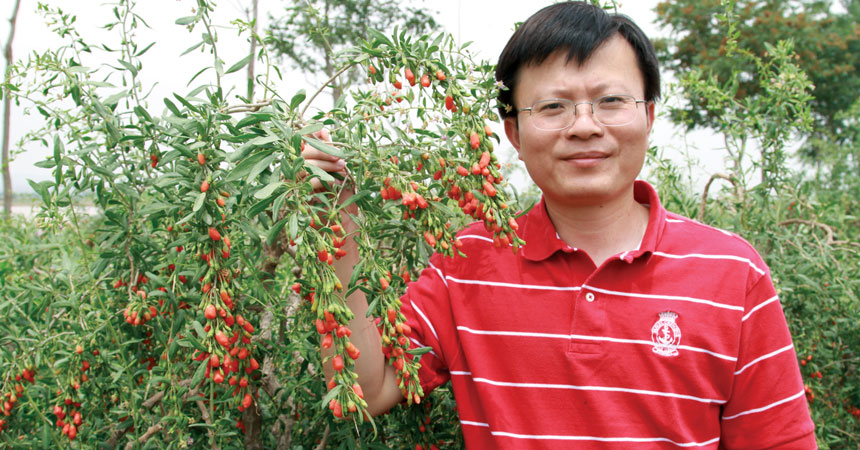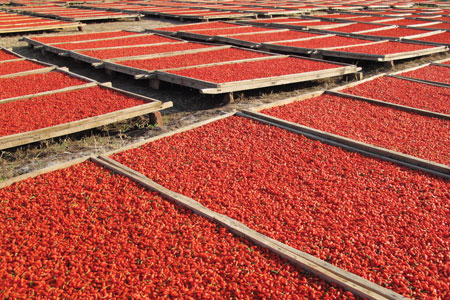Ancient Berry’s Rich Future
Wednesday, March 22, 2017

Little red and orange wolfberries have been used in China for centuries to ensure longevity and treat age-related conditions of the liver and the eye. But those qualities and many more have only recently been confirmed by researchers using modern high performance analytic methods.
College of Human Sciences assistant professor in nutritional sciences Daniel Lin and his colleagues are providing evidence of the berry’s effectiveness on retinal degeneration.
Wolfberries, or Goji berries, are the fruits of two closely related perennial plants, Lycium barbarum and Lycium Chinense, which are native to Asia and southeast Europe. Commercial production mainly comes from plantations in the Ningxia Hui and Xinjiang Uyghur regions in China.
The bioactive components in wolfberries include polysaccharides and carotenoids, among others. The fruits contain high levels of the carotenoids lutein and zeaxanthin, which are believed to have significant importance in eye health. Lin and his colleagues studied the preventative effects of dietary wolfberry on diabetic retinopathy.
During the study, mice were fed a diet that included 1 percent wolfberries. The control group’s diet did not include wolfberries. High-performance liquid chromatography indicated mice fed the wolfberry diet for eight weeks had increases of around 13.7 percent in overall zeaxanthin and lutein concentrations in liver and retinal tissues.

Retinal damage caused by diabetes is the leading cause of vision impairment and blindness in working age adults. Hyperglycemia (high blood sugar) is a major cause of the progression of the disease. No permanent cure is currently available.
Mitochondria are often referred to as the powerhouse of the cell because they generate most of the cell’s supply of adenosine triphosphate, the source of the cell’s energy. Mitochondrial dysfunction is the primary indicator of retinal degeneration in diabetes. Mitochondria damage in mice fed wolfberries for eight weeks was completely reversed. The study showed wolfberry improved dispersion of mitochondria and increased pigment granules in the retina’s epithelium cells.
The vascular system in the retina provides nutrients and oxygen to the inner retina; new blood vessels supply the outer retina. In diabetes, elevated blood glucose, hyperglycemia and blood flow decline result in hypoxia or oxygen shortages in the retina. Dietary wolfberries ameliorated hypoxia and slowed down vascular dysfunction in the retina of the mice.
“In the study, dietary wolfberry restored the thickness of the whole retina, in particular the inner nuclear layer and photoreceptor layer,” Lin says.
“To our knowledge, this is the first report that wolfberry bioactive constituents prevented or delayed the onset of the disease of diabetic retinopathy in an animal mode,” Lin says.
“We believe the inhibition of hypoxia may be beneficial to maintaining healthy vision for diabetic patients,” he says. “The bioactive components in wolfberry may very well delay the progression of retinal degeneration for people suffering from diabetes.”
Not satisfied with one aspect of wolfberries’ impact on health, Lin is also studying its effects on obese mice.
“High-fat diets cause mitochondrial dysfunction, and a study of obese mice indicates wolfberry dietary intervention can lead to the prevention of excessive amounts of triglycerides and other fats in liver cells,” Lin says.
With the burgeoning costs associated with pharmaceutical treatments, research-based evidence of the lasting effects of nutraceuticals such as wolfberries will have tremendous impact on the health and well-being of the world’s population.
Lin said the western world is taking notice of the tiny fruit’s potential as wolfberry production is being found in Arizona, California and Nevada.
“Shipping the fresh fruit is difficult, so most of the fruit from China is dried,” he says. “The dried fruit is still highly effective, but as with all fruits, fresh wolfberry is best.”
It appears the ancient remedy may well soon be the next new functional food to enhance and improve health.
Story by Julie Barnard
